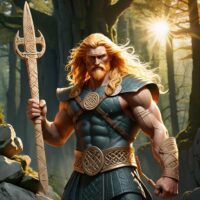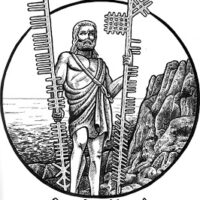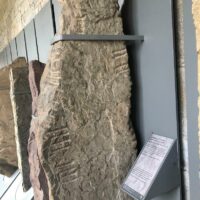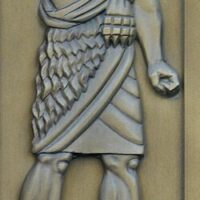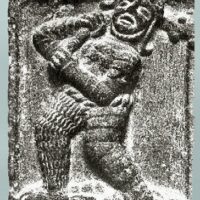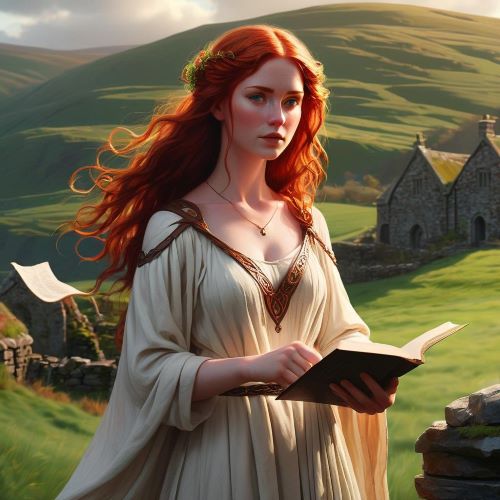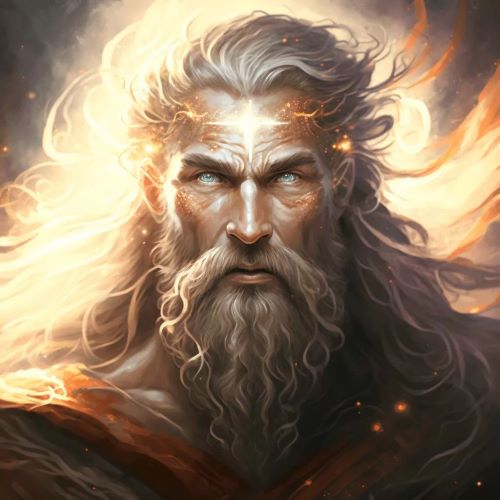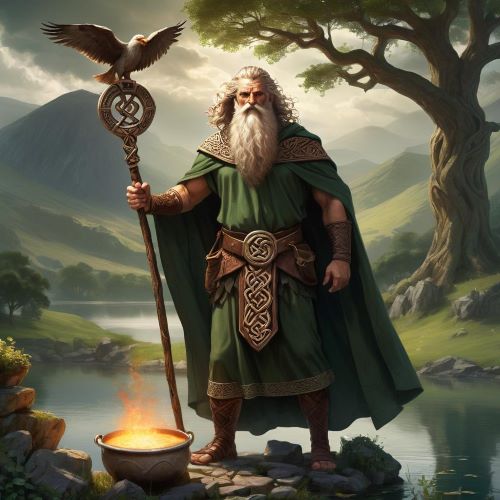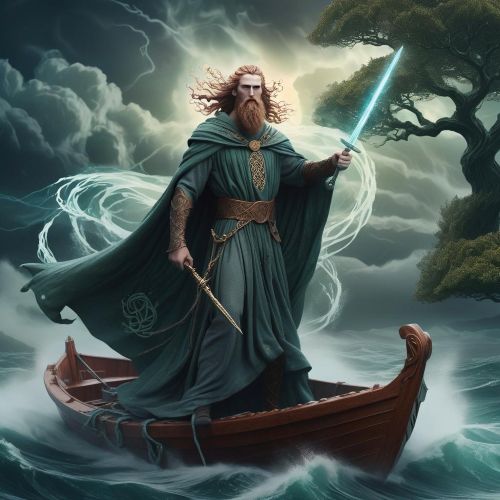Ogma : God of Eloquence
Listen
At a glance
| Description | |
|---|---|
| Origin | Irish Mythology |
| Classification | Gods |
| Family Members | Elatha (Father), Ethniu (Mother), Dagda, Lugh (Brothers), Delbáeth, Tuireann, Banba, Fótla, Éire (Children) |
| Region | Ireland |
| Associated With | Learning, Wisdom, Benevolence |
Ogma
Introduction
Ogma, a revered figure in Irish mythology, is best known as the god of eloquence, learning, and the written word. A distinguished member of the Tuatha Dé Danann, the supernatural race of deities and heroes in Irish lore, Ogma stands out not only for his martial prowess but also for his intellectual brilliance. He is credited with inventing the Ogham script, Ireland’s earliest form of writing, which underscores his central role in preserving culture and language. His character embodies the powerful union of mind and body—wisdom sharpened by the strength of a warrior.
Physical Traits
Ogma’s appearance reflects his dual identity. Ancient tales often describe him as a swarthy, imposing warrior with a radiant or sun-like face, earning him the epithet “Grianainech.” This brightness is not just literal but symbolic, suggesting the enlightening power of speech and knowledge. Despite his scholarly associations, Ogma’s physique was a symbol of immense physical strength, a reminder of his skill in combat. Some stories recall his sheer power, such as lifting or hurling impossibly large stones, feats that showcased strength equal to the gods of war. Yet, in contrast, depictions of him in later mythology present a sage-like demeanor, aged and wise, highlighting his evolution from warrior to revered teacher.
Family
Ogma’s ancestry and family affiliations root him firmly within the pantheon of Irish divine nobility. Often portrayed as the son of the Dagda, the great father-figure and king of the Tuatha Dé Danann, and possibly the goddess Danu, Ogma’s lineage is both powerful and sacred. He is frequently positioned as a close relation—whether by blood or brotherhood—to deities like Lugh, a god of many skills, and the fierce Morrigan. Through these connections, Ogma gains a broader mythological context, sharing in the triumphs and challenges that defined the fate of the Tuatha Dé Danann. His own offspring, such as Cairbre and Tuireann, extend his influence into further cycles of Irish legend, continuing the legacy of leadership and knowledge.
Other names
The many names and titles attributed to Ogma reflect the multifaceted nature of his identity. Among the most well-known is “Grianainech,” meaning “sun-faced,” evoking his radiant wisdom and illuminating speech. In Gaulish mythology, his equivalent appears as Ogmios, a deity also associated with eloquence and persuasion, often imagined as a Herculean figure leading followers by chains of gold extending from his tongue to their ears—an allegory for the persuasive power of speech. Other names like “honey-mouthed” suggest his poetic and oratorical finesse, reinforcing his status as a master of language and storytelling. Each name contributes to an evolving image of Ogma as both a fearsome hero and a gentle sage.
Powers and Abilities
Ogma’s abilities span across domains often viewed as opposites—violence and intellect, battle and poetry. Most notably, he is celebrated as the creator of the Ogham alphabet, an ancient system of writing used on stones and wood that became a cornerstone of early Irish culture. This invention linked him directly to the druids and poets who served as keepers of lore and law. His speeches could rally armies or negotiate peace, his verses could immortalize deeds, and his inscriptions could preserve sacred knowledge. In battle, Ogma was a champion for the Tuatha Dé Danann, fighting valiantly in major mythological conflicts such as the First and Second Battles of Mag Tuired. His mental prowess equaled his physical strength, making him a symbol of ideal balance—someone who could win with words as easily as with weapons.
Modern Day Influence
Ogma’s presence can still be felt in today’s cultural and spiritual landscapes. The revival of Celtic spirituality and neopagan practices often includes homage to Ogma as a god of wisdom and communication. Modern druidic movements, in particular, revere him as a divine teacher and guardian of sacred language. His invention—the Ogham script—has experienced a resurgence in scholarly and spiritual circles, appearing on jewelry, tattoos, and in artistic renditions as a symbol of ancient Irish identity and wisdom. Beyond spirituality, Ogma’s archetype has found its way into modern fantasy literature and role-playing games, where characters inspired by him often combine knowledge, persuasion, and combat prowess. In educational discourse, his figure is invoked to emphasize the historical importance of literacy and oral tradition in Irish society. He stands as a lasting representation of how stories shape civilizations, and how language wields the power to conquer more than just enemies—it conquers time.
Related Images
Source
MacCulloch, J. A. (1911). The religion of the ancient Celts. Dover Publications. https://archive.org/details/religionofancien00maccuoft
Stokes, W. (1891). The Second Battle of Moytura. Revue Celtique, 12, 52–130. https://www.ucd.ie/tlh/trans/ws.rc12.html
Fraser, J. (1915). The First Battle of Moytura. Ériu, 8, 1–63. https://www.ucd.ie/tlh/trans/jf.eriu8.html
Jones, M. (2019). Oghma Grianainech. Jones’s Celtic Encyclopedia. https://www.maryjones.us/ctexts/oghma.html
Mac Cana, P. (2025). Celtic religion. Encyclopedia Britannica. https://www.britannica.com/topic/Celtic-religion
Editors of Encyclopaedia Britannica. (2025). Ogma. Encyclopedia Britannica. https://www.britannica.com/topic/Ogma
IrelandWide. (2024). Ogma: Celtic god of learning and writing. https://irelandwide.com/ogma-god-of-learning/
Irish Pagan School. (2023). Stories of Celtic mythology: Legends of Ogma. https://irishpagan.school/legends-of-ogma/
Stifter, D. (2025). Ogam, Ogma and Ogmios. OG(H)AM Project. https://ogham.glasgow.ac.uk/index.php/2025/03/05/ogam-ogma-and-ogmios/
Frequently Asked Questions
What is lorem Ipsum?
I am text block. Click edit button to change this text. Lorem ipsum dolor sit amet, consectetur adipiscing elit. Ut elit tellus, luctus nec ullamcorper mattis, pulvinar dapibus leo.
What is lorem Ipsum?
I am text block. Click edit button to change this text. Lorem ipsum dolor sit amet, consectetur adipiscing elit. Ut elit tellus, luctus nec ullamcorper mattis, pulvinar dapibus leo.
What is lorem Ipsum?
I am text block. Click edit button to change this text. Lorem ipsum dolor sit amet, consectetur adipiscing elit. Ut elit tellus, luctus nec ullamcorper mattis, pulvinar dapibus leo.
What is lorem Ipsum?
I am text block. Click edit button to change this text. Lorem ipsum dolor sit amet, consectetur adipiscing elit. Ut elit tellus, luctus nec ullamcorper mattis, pulvinar dapibus leo.
What is lorem Ipsum?
I am text block. Click edit button to change this text. Lorem ipsum dolor sit amet, consectetur adipiscing elit. Ut elit tellus, luctus nec ullamcorper mattis, pulvinar dapibus leo.


